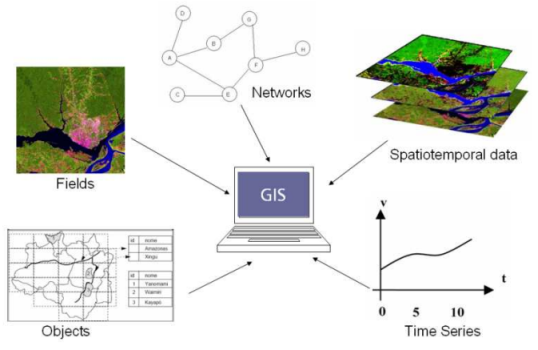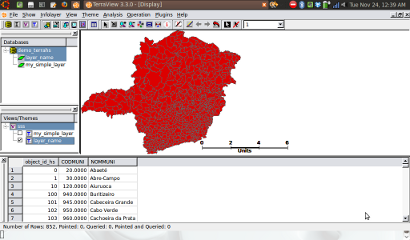TerraHS: Difference between revisions
No edit summary |
No edit summary |
||
| Line 7: | Line 7: | ||
Developing geographic information systems is a complex task. GIS applications involve data handling, algorithms, spatial data modeling, spatial ontology and user interfaces. The diversity of structures such as networks, fields, objects, time series and spatial temporal data types , is an intimidating problem for GIS developers. | Developing geographic information systems is a complex task. GIS applications involve data handling, algorithms, spatial data modeling, spatial ontology and user interfaces. The diversity of structures such as networks, fields, objects, time series and spatial temporal data types , is an intimidating problem for GIS developers. | ||
[[Image:General view terrahs.png Diversity of data types in a GIS program]] | [[Image:General view terrahs.png|Diversity of data types in a GIS program]] | ||
Research in Geographic Information Science has shown that many spatial data can be expressed as algebraic theories. These algebraic theories formalize spatial components in a rigorous and generic way. As an answer to the challenges of translation of algebraic specifications into computer languages, there has been a growing interest in functional languages. So, the TerraHS is an application development system that enables prototyping novel GisScience ideas in Haskell. | Research in Geographic Information Science has shown that many spatial data can be expressed as algebraic theories. These algebraic theories formalize spatial components in a rigorous and generic way. As an answer to the challenges of translation of algebraic specifications into computer languages, there has been a growing interest in functional languages. So, the TerraHS is an application development system that enables prototyping novel GisScience ideas in Haskell. | ||
Revision as of 18:56, 24 November 2009
What is it ?
 is a software component that enables the development of geographical applications in a functional language, using the data handling capabilities of TerraLib. TerraLib is a C++ library that supports different spatial database management systems, and that includes a large number of spatial algorithms. As a result, we get a combination of the good features of both programming paradigms.
is a software component that enables the development of geographical applications in a functional language, using the data handling capabilities of TerraLib. TerraLib is a C++ library that supports different spatial database management systems, and that includes a large number of spatial algorithms. As a result, we get a combination of the good features of both programming paradigms.
Developing geographic information systems is a complex task. GIS applications involve data handling, algorithms, spatial data modeling, spatial ontology and user interfaces. The diversity of structures such as networks, fields, objects, time series and spatial temporal data types , is an intimidating problem for GIS developers.
Research in Geographic Information Science has shown that many spatial data can be expressed as algebraic theories. These algebraic theories formalize spatial components in a rigorous and generic way. As an answer to the challenges of translation of algebraic specifications into computer languages, there has been a growing interest in functional languages. So, the TerraHS is an application development system that enables prototyping novel GisScience ideas in Haskell.
Features
The major features are:
- Input and output formats: Layers or themes from TerraLib databases (just MySQL), Esri Shape File (*.shp), TIFF file.
- Data types: Raster or image (just 8 bits), Vectors (Point, Line, Polygon and Cell), Temporal (DateTime, Interval)
- Topological operators: intersects, within, touches, crosses ...
- Geometric operations: intersection, union, difference, rotation.
- Metrical operations: perimeter, area, distance, centroid, shapeindex, compacity, fractal
Demos
The following figure is one example of a vector data can be exported to a TerraLib database, and then it can be visualized with TerraView.
The pattern for a main program in TerraHS has the folowing structure:
module Main(main) where
import TerraHS
host = "localhost";
dbname = "demo_terrahs";
user = "root";
password = "root";
main:: IO()
main = do
-- loading a vector data from a shape file
gos <- loadVectorFile "MG_MUN96.shp"
-- open a connection
db <- open (TeMySQL host user password dbname)
-- saving in a database layer
store db "layer_name" gos
print "saved"Two different outcomes from a image data and theirs respective operations (a)input image, (b) inverted image and (c) reverse image.
The following examples use this data:
- Opening and saving shape file
- Opening a shape file and saving in database
- Opening and save tiff image files
- Simple spatial operations demo
- Understanding how to create a geoobject data type
- Opening a raster data from database
- Opening a tiff file and saving in database
- Loading geoobjects from a database and saving a shape file
Its possible to run in the ghci:
#ghci SpatialOper.hs
printing some test values, e.g.:
Main> main Loading package syb ... linking ... done. Loading package base-3.0.3.0 ... linking ... done. Loading package terrahs-0.8 ... linking ... done. TePoint (12.5,10.0) TeLine2D [(1.0,1.0),(1.0,2.0),(1.0,7.0)] TePolygon [TeLine2D [(1.0,1.0),(1.0,2.0),(3.0,2.0),(3.0,1.0),(1.0,1.0)]] False True False 2.0
or compile and run:
#ghc SpatialOper.hs -package terrahs-0.8 -o main #main
More details about the api in source documentation - online (HTML)
Download and Installation
TerraHS is available in cabal package from Hackage. See How to install a Cabal package in Linux or Windows.
Installation notes for Linux
Software dependencies in debian package
The installation procedure:
#sudo dpkg -i package.deb
The uninstallation procedure:
#sudo dpkg -r package
Software dependencies in source file
The installation procedure:
#tar xvzf package.tar.gz #cd package #./configure #make #sudo make install
The uninstallation procedure:
#cd package #sudo make uninstall
Installation notes for Windows
Coming soon
Software dependencies
TerraHS is a Haskell GIS application built using the TerraLib GIS library. In below, is available a debian packages for TerraLib. TerraHS-0.8 uses the TerraLib-3.3.0 version.
![]() TerraLib-3.3.0 for (Ubuntu 9.04 (x86))
TerraLib-3.3.0 for (Ubuntu 9.04 (x86))
Optional, but is recommended to install the TerraView application.TerraView is a GIS application based on TerraLib, a GIS library to handle vector and raster data in geographical DBMS such as Access, PostgreSQL, MySQL and Oracle Spatial.
![]() TerraView-3.3.0 for (Ubuntu 9.04 (x86))
TerraView-3.3.0 for (Ubuntu 9.04 (x86))
The TerraLib and TerraView source files can be downloaded from official sites:
We have developed some specific libraries to support some functionalities for TerraHS. The libraries can be installed from an unique package (TerraLib4c+Translib)
![]() TerraHSdependecies for Ubuntu 9.04 (x86)
TerraHSdependecies for Ubuntu 9.04 (x86)
Or can be download in separated way:
Translib, a library for translation among different geographic format files (no database connection), based in the TerraLib library. This library is required for TerraHS to deal whith shape files (*.shp).
Terralib4c, a library that maps c++ Terralib functions and classes to C functions. Required by Haskell to do binding with TerraLib api.
Papers, thesis and Reports
Some papers and thesis that use TerraHS:
- Sérgio Costa, Gilberto Câmara, et.al. Prototyping GIS Application in Functional Programming. In: GeoPantanal, 2009, Corumbá. Anais do II Geopantanal, 2009. download
- Costa, S. S., Câmara, G., & Palomo, D. (2007). TerraHS: Integration of Functional Programming and Spatial Databases for GIS Application Development. (pp. 127-149). Advances in Geoinformatics. Springer. link
- Sergio Costa, Gilberto Câmara, Danilo Palomo. TerraHS: Integration of Functional Programming and Spatial Databases for GIS Application Development. VIII Brazilian Symposium in Geoinformatics, GeoInfo 2006, Campos do Jordão, 2006. download
- Olga Bittencourt, Gilberto Câmara, Lúbia Vinhas, Joice Mota. Rule-based Evolution of Typed Spatio-temporal Objects. IX Brazilian Symposium in Geoinformatics, GeoInfo 2007, Campos do Jordão, 2007.download
- Sérgio Rosim. Estrutura baseada em grafos para representação unificada de fluxos locais para modelagem hidrológica distribuída. PhD Thesis in Computer Science at INPE, 2008.download


